On Monday I returned from a six-day visit to Albania, my first proper dark-tourism trip this year! I was based in the capital Tirana and did most of my fieldwork there, but also went on a guided day trip to one of the former communist-era prisons/hard labour camps in the mountains in the north of the country … but that will be for another separate Blog Post some time soon. For this post I’m going to concentrate on Tirana only.
It was my second visit, the first having been in 2011 as part of my larger Balkans trip back then, when I had only two days in Tirana. This is normally enough, but I allocated a few more days on this occasion, so was able to take things at a more leisurely pace.
The city has, on the one hand, changed a lot, on the other not at all. Traffic is still chaotic and anarchic, air pollution is bad, and for the most part you can’t really say that Tirana is a beautiful city. There are a few special spots in the centre, yes, but most of the cityscape is pretty drab – mostly just socialist-era residential housing blocks interspersed with newer constructions.
The centre point remains Skanderbeg Square. It is also here that perhaps one of the most famous sights of Albania is located: the National History Museum with its huge socialist-realist mosaic on the front facade. Back in 2011, to my disappointment, I found it invisible, hidden behind scaffolding, so I was looking forward to seeing it in the flesh, as it were, this time around. Imagine my renewed disappointment when I got there and AGAIN found it covered and behind scaffolding. At least they put a full-size image of the mosaic on the covering this time:
.
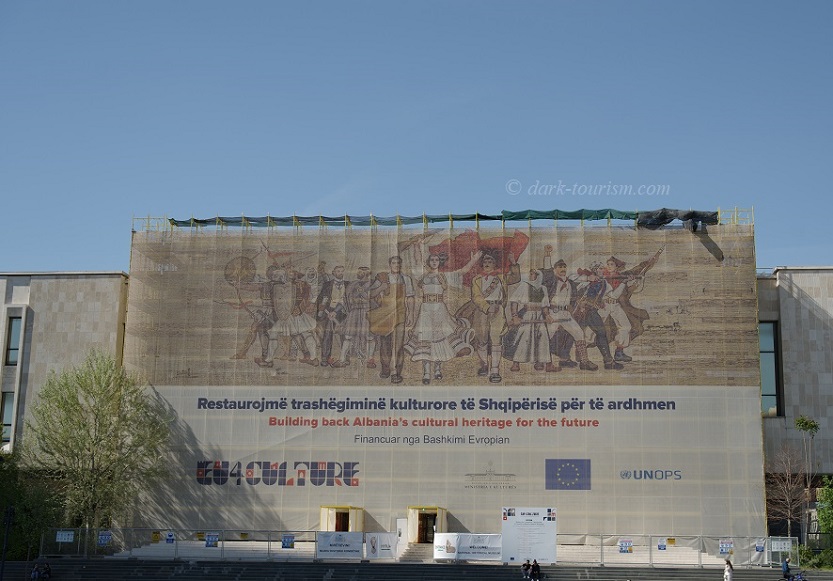
.
Whatever restoration work they may have done to the mosaic back in 2011 must have been shoddy enough for it now requiring a fresh refurbishment effort (this time with funding by the EU).
I also went inside the museum. I was somewhat surprised in 2011 that the entire post-WWII period of Enver Hoxha and communism wasn’t covered at all. I had already been alerted by readers that this had changed in the meantime so I went to check it out. What I found was rather disappointing. There is a new section about the victims of communism and the period of the collapse of the socialist regime, but, like the rest of the museum, it’s very old-fashioned and stuffy and mostly in Albanian only. Moreover, photography was forbidden. Overall it was a lowlight of the trip.
Much of the cityscape in the centre of Tirana has changed dramatically and continues to change. I found at least five skyscraper construction sites and a couple more that were just being finished. The same applies to a brand-new large mosque, apparently constructed with funds from Turkey (going by the large Turkish flag that was flying between the minarets during the last few days of my visit):
.

.
One change affecting the DT appeal of Tirana is what’s happening at the legendary “Tirana Pyramid” (aka “Hoxha Pyramid”). It featured in the “Red Urbex” video series on Arte TV that this recent Blog Post was about. That episode, and the current chapter on my main website, are now outdated. As you can also see on Google Maps, the “pyramid” is now a construction site, currently looking like this (same photo as at the top of this post):

The structure is being gutted and will then be converted into some sort of IT education space with cafes and shops, as a mixed-use public space. On the fence around the construction site are posters giving “artists’ impressions” of the future look of the site, such as this:

You can find more about the Dutch design team’s plans on their website here (external link – opens in a new tab). Obviously they paint a rosy picture of the structure’s future. While I can see its merits as a public space and the value of repurposing rather than demolition (as was at one point suggested, but prevented by a public outcry), it’s still a bit of a loss from a DT perspective, though. Its looks will be changed substantially and I can’t see any reference to Hoxha being included.
When we were there last week, my wife tried to open a door in the construction fence and to her surprise found it not locked. Directly behind was a guard, though, so she quickly closed the door again apologetically. But then the guard opened it again and invited us in for a candid look around and even allowed photography, but made one thing clear: “no Internet!”. So I can’t reproduce any of the photos I took there here (the above photo was taken from across the road, i.e. outside the fence perimeter). The guard led us to the big opening at the front from where you could see right to the top of the inside of the pyramid. And up there in the centre was the shape of a five-pointed red star, the old symbol of communism! This will definitely not survive, as you can see from the designers’ images.
Just across the main road is a small park which features some installations entitled “checkpoint”, and this includes a segment from the Berlin Wall, a small bunker and some elements taken from the former political prison of Spaç (which I also visited on this trip):
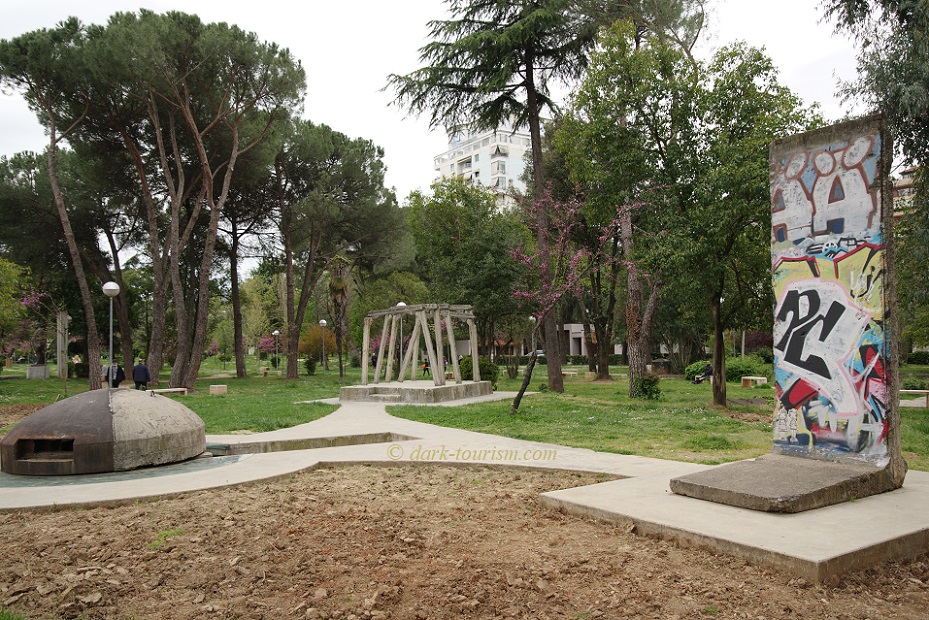
This hadn’t been there yet when I first visited in 2011. I’d seen plenty of bunkers in the countryside, especially near the borders, but not right in the centre of Tirana! I presume they were not originally there but were moved in from elsewhere. In general, Albania seems to be embracing this unique kind of legacy from the communist period when dictator Enver Hoxha had thousands and thousands of such bunkers built all over the country for “self-defence”. The park in Tirana has two more of them and I spotted another one in the garden of the hotel I stayed in. And souvenir shops now sell little scale-model pill-box bunkers! (And before you ask, yes, I couldn’t help myself and bought one …)
Just behind the park is a building marked as “government residence” with a guard on duty, and just inside the premises I spotted something familiar, namely a Stalin statue that used to stand in the backyard of the National Art Gallery. I approached the guard to ask whether it was indeed the same one, but he was quite monosyllabic and stern, saying nothing but “no!” (i.e. no access, beat it!). Peeking through the fence to the side of the building, though, I saw that the old Lenin statue has also been moved here, together with some old jeep from the Cold War era:

The previous location, the National Art Gallery, is yet another sight currently closed and undergoing refurbishment work. I peeked over the construction site fence and saw a big hole in the ground behind the main building and rubble chutes coming down from the upper floor. It seems they are gutting this building too. I wonder what it might mean for the contents of the Gallery. Back in 2011 it was full of rather remarkable socialist-realist paintings. I hope they’ll survive and will go back on display.
The fence around the Gallery, however, sported some graffiti and street art with very current themes, such as this one:

In the Blloku, the former gated district reserved for only the communist party elite, now a cafe and bar scene hub, stands the former residence of dictator Enver Hoxha, still closed and off limits:

A couple of years ago I read an article that suggested that this mansion, preserved in the state it was in when the dictator died in 1985, would possibly be opened to the public. But this hasn’t happened yet. It certainly would make a very special addition to Tirana’s dark-tourism portfolio, going by the photos in that article (external link, opens in a new tab).
The most significant additional attraction that has opened since my first visit in 2011, however, was also the highlight of my trip last week: a vast underground bunker system from the Cold War in which Hoxha and the party elite would have sought shelter in the event of war. It’s now a museum and art & events space called BUNK’ART 1. Here’s the entrance:

The bunker is inside a mountain on the north-eastern edge of Tirana and consists of over a hundred rooms on five levels, not on top of each other but next to each other, following the slope on the side of the mountain, connected by one long main corridor:

About two thirds of the system have been made accessible to the public, including five of the nine side tunnels connecting the main tunnel to the outside world. The rooms for the prime minister and for Enver Hoxha himself can be seen too. Here’s the dictator’s private bedroom (which he never used, though):

The largest space in the bunker is this huge assembly hall, now used as an event space:

The rest of the bunker is partly a historical museum, partly a space for various art installations. One room has been reconstructed as a typical living room of communist-era Albania:

A couple of years after the opening of Bunk’Art 1, a second underground site was opened to the public in the centre of Tirana in 2016 and named “BUNK’ART 2”. This is a tunnel system underneath the Ministry of Internal Affairs to which the infamous Sigurimi political police was attached. The entrance and exit have been newly constructed to allow access from outside the ministry building. Again you enter a system of tunnels such as this:
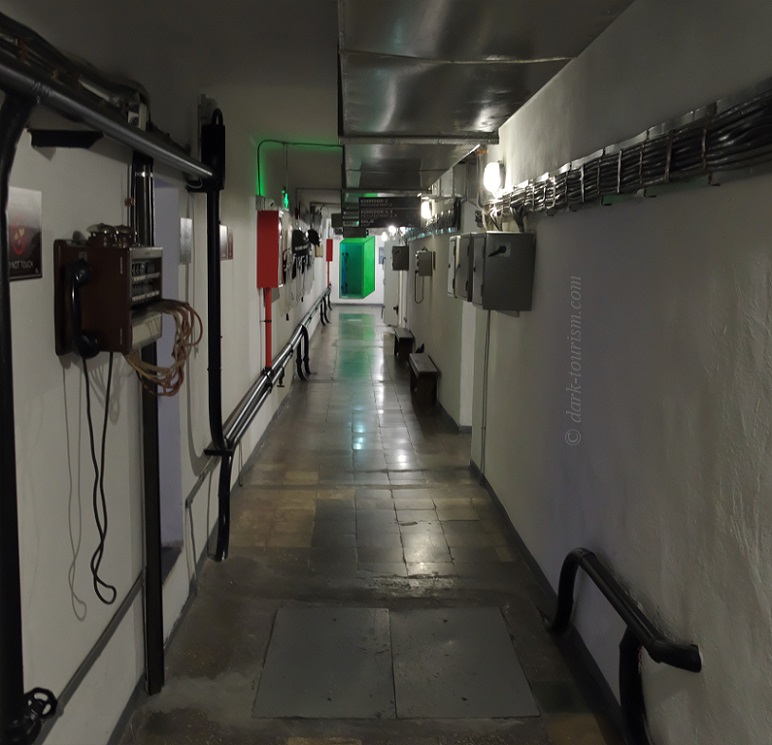
As part of the museum exhibition inside there are reconstructions of secret police offices such as this one, complete with a photo of dictator Enver Hoxha on the wall:
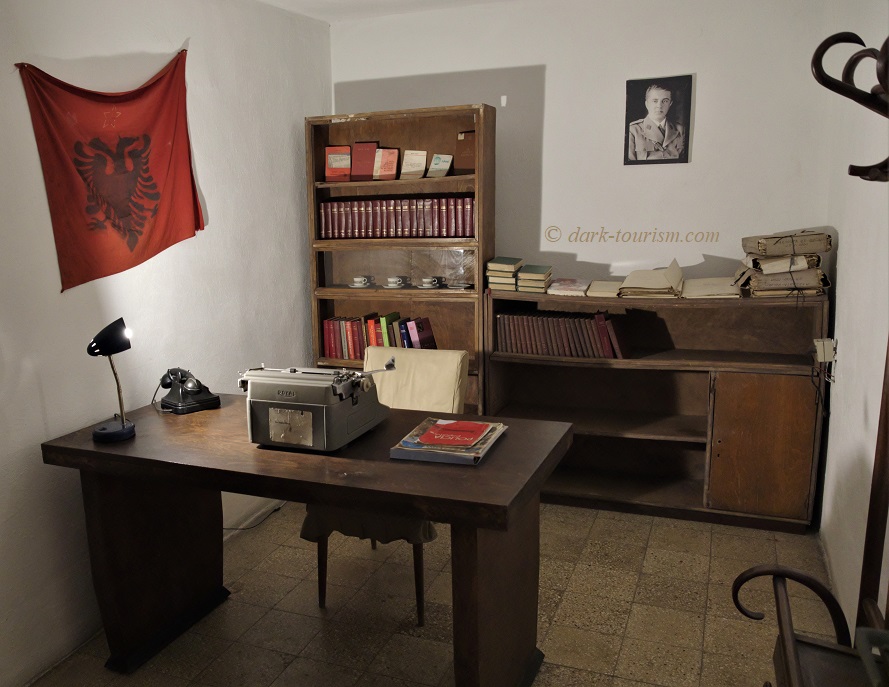
In one room the secret surveillance methods of the Sigurimi are illustrated, including a hidden camera and microphone:

The two Bunk’Art sites have become very firmly part of the tourism landscape of Tirana. In fact they are ranked at the top two places on the list of the city’s attractions on Tripadvisor! This success may have helped along a more open recognition of Albania’s dark past that was still largely absent when I first visited in 2011.
The latest addition to this newer portfolio of dark-tourism-relevant attractions is the House of Leaves, the former HQ of the Sigurimi secret police:

Inside you find on display all manner of surveillance and spying technology and lots of documents produced by the secret police – but photography was not allowed inside. So I’ll leave it at this external shot only.
Out in the southern suburbs of Tirana is the National Martyrs’ Cemetery, where partisans who fell during the liberation of Albania in 1944 are buried:
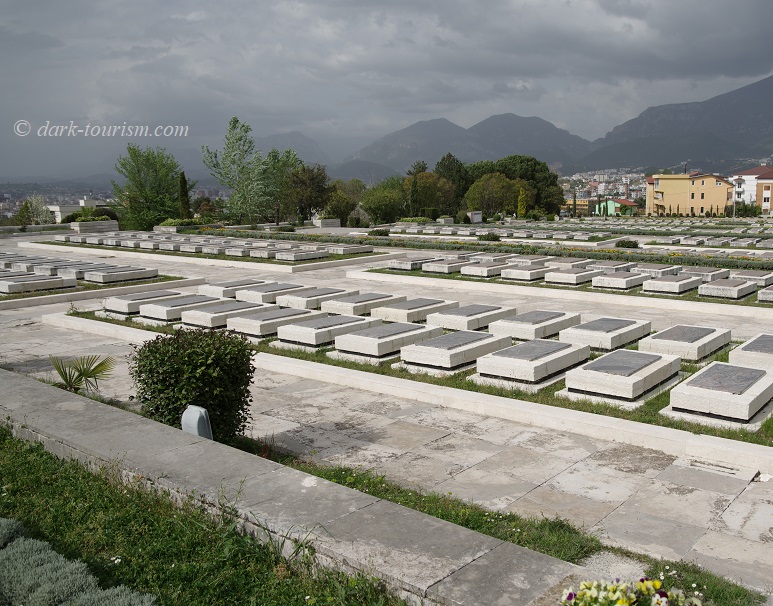
Towering above the site is the giant Mother Albania statue:

It was also here, right next to Mother Albania, that Enver Hoxha, Albania’s iron-fist dictator for 41 years, was initially buried after his death in 1985. But following the eventual collapse of communism in Albania in 1990/91, he was exhumed and re-interred elsewhere (see below). This is what I presume was his original grave (though I cannot be sure), now a memorial to victims of communism:

On our final day in Tirana we also made the “pilgrimage” to Enver Hoxha’s second (and current) grave out on the south-western fringes of the city in Tirana’s main municipal cemetery. It’s a simple slab, with just his name and years of birth and death on it, behind two pillars holding an Albanian double eagle symbol (as in the country’s marvellous national flag), seen here partly hidden by plastic flowers. Apparently, the old dictator still has some admirers who leave flowers for him:

Finally, right at the end of the trip while we waited for our flight home, I was in for a pleasant surprise. At the airport’s book shop we spotted a copy of my book Atlas of Dark Destinations on display:

When my wife, who spotted it first, alerted me to it I actually jumped, such was the surprise. I had been sent photos of my book on shop shelves (sent to me by readers), but this was the first time I encountered it physically on sale. I was also pleased by the fact that it was put in a section with books on modern history and politics, so it felt in good company, as it were … well, maybe except for the copy of “Putin’s People” 😉 …
I bought a copy of another book, as I had just finished one and needed new reading material. When I paid for it at the till I told the shop assistant that I happened to be the author of the Atlas of Dark Destinations, pointing at it, and offered to sign the display copy (for free), but she just kept giggling. I presume she thought I was just pulling her leg. Well, their loss …
But so much for a short report from my most recent DT travels. In due course I will also add a stand-alone Blog Post about my excursion to Spaç prison. Please bear with me …




4 responses
Love this blog about Albania…. and cream on the cake to see your book in the flesh
thanks! And indeed it was a pleasant surprise to see my book there. Very good book shop otherwise too, by the way. Bought only one, but several others were beckoning too … but with hand luggage restrictions, only one could be picked 😉
Thanks for the informative post and to see how much things have moved on since I was there a few years back, especially with the Grand Pyramid of Doom! One thing I noted about Tirana was the excellent quality of the food there – ok, not exactly a regular dark tourism topic, but worth noting all the same.
oh indeed, we had outstanding traditional Albanian food too, good choices for vegetarians … not key to DARK tourism, true, but for us culinary explorations are always a supremely imporant aspect of travelling in general!